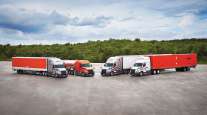Schneider’s Profits, Revenue Higher in Third Quarter

Schneider National Inc. reported higher revenue and profits in the third quarter, but not all of its business units shared in the bounty.
A lack of drivers forced the Green Bay, Wis.-based company to move a bigger share of its truckload freight to rail intermodal and to channel more investment into dedicated contract carriage services. Company executives also have taken steps to shore up a relatively new First to Final Mile delivery business that is expected to be a drag on earnings this year and into 2019.
Overall, Schneider earned $70.7 million , or 40 cents a share, in the three months ended Sept. 30, compared with $36.9 million, or 21 cents a share, in the same period a year ago. Revenue grew 15% to $1.28 billion in the third quarter of 2018 from $1.11 billion in 2017.
While those results were “excellent,” CEO Chris Lofgren said the company found it difficult to expand its fleet of trucks to meet demand.
LOFGREN RETIRING: Rourke to take over as CEO
“Given the continued tightness in driver availability,” Lofgren said in a statement Nov. 1, “the company pivoted its capital allocation by adding containers to our intermodal business, providing profitable enterprise growth in a less-driver-intensive business.”
In fact, intermodal and non-asset-based logistics services accounted for 90% of Schneider’s revenue growth in the third quarter and 50% of operating earnings, Lofgren told investment analysts in a conference call after the release of its earnings. By comparison, intermodal and logistics generated 50% of the company’s revenue growth and 31% of operating earnings in the third quarter of 2017.
Regarding the First to Final Mile business, Lofgren said the company remains committed to the market for home delivery of heavy goods but that changes are necessary in the company’s approach.
“We created a champagne-and-caviar offering for people that really just want a good beer and brat,” Lofgren said.
“In our zeal, we got a little ahead of our ski tips on this and … we have no one to blame but ourselves.”
In the third quarter, Schneider reported a loss of $9.5 million on the First to Final Mile business, which it attributed to sluggish furniture and flooring volumes, a bankruptcy write-off and operational inefficiencies.
To fix the problem, Lofgren said the company has brought in new management and is revamping operations to de-emphasize custom-delivery and to offer more standardized service at a lower cost.
Notwithstanding those problems, Schneider said its truckload business overall remained profitable, generating operating income of $53.1 million in the third quarter of 2018, an increase of 29% from 2017. Revenue increased 2% to $565 million.
The company’s truckload business ended the quarter with an average of 11,393 company-owned and owner-operator tractors compared with 11,890 in the same period a year ago.
Intermodal was the standout business for Schneider in the third quarter with operating income nearly doubling to $36.1 million and revenue climbing 29% to $242.1 million
The company’s intermodal unit finished the quarter with 21,288 containers and 1,482 trucks, compared with 17,557 containers and 1,293 trucks a year ago.
Revenue from logistics services, which includes freight brokerage and warehousing services, also grew 29% to $268.7 million in the quarter, while income from operations increased 37% to $12.5 million.
Schneider ranks No. 7 on the Transport Topics Top 100 list of largest for-hire carriers in North America and No. 18 on the Transport Topics Top 50 list of largest logistics companies in North America.




